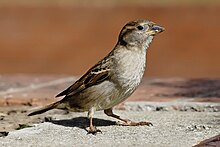Anatomy and physiology
Main articles: Bird anatomy and Bird vision

External anatomy of a bird: 1 Beak, 2 Head, 3 Iris, 4 Pupil, 5 Mantle, 6 Lesser coverts, 7 Scapulars, 8 Median coverts, 9 Tertials, 10 Rump, 11 Primaries, 12 Vent, 13 Thigh, 14 Tibio-tarsal articulation, 15 Tarsus, 16 Foot, 17 Tibia, 18 Belly, 19 Flanks, 20 Breast, 21 Throat, 22 Wattle
Compared with other vertebrates, birds have a body plan that shows many unusual adaptations, mostly to facilitate flight.
The skeleton consists of very lightweight bones. They have large air-filled cavities (called pneumatic cavities) which connect with the respiratory system.[38] The skull bones in adults are fused and do not show cranial sutures.[39] The orbits are large and separated by a bony septum. The spine has cervical, thoracic, lumbar and caudal regions with the number of cervical (neck) vertebrae highly variable and especially flexible, but movement is reduced in the anterior thoracic vertebrae and absent in the later vertebrae.[40] The last few are fused with the pelvis to form thesynsacrum.[39] The ribs are flattened and the sternum is keeled for the attachment of flight muscles except in the flightless bird orders. The forelimbs are modified into wings.[41]
Like the reptiles, birds are primarily uricotelic, that is, their kidneys extract nitrogenous wastes from their bloodstream and excrete it as uric acid instead of ureaor ammonia via the ureters into the intestine. Birds do not have a urinary bladder or external urethral opening and (with exception of the Ostrich) uric acid is excreted along with feces as a semisolid waste. However, birds such as hummingbirds can be facultatively ammonotelic, excreting most of the nitrogenous wastes as ammonia.[45] They also excrete creatine, rather than creatinine like mammals. This material, as well as the output of the intestines, emerges from the bird's cloaca. The cloaca is a multi-purpose opening: waste is expelled through it, birds mate by joining cloaca, and females lay eggs from it. In addition, many species of birds regurgitate pellets. The digestive system of birds is unique, with a crop for storage and a gizzard that contains swallowed stones for grinding food to compensate for the lack of teeth.[49] Most birds are highly adapted for rapid digestion to aid with flight.[50] Some migratory birds have adapted to use protein from many parts of their bodies, including protein from the intestines, as additional energy during migration.
Birds have one of the most complex respiratory systems of all animal groups. Upon inhalation, 75% of the fresh air bypasses the lungs and flows directly into a posterior air sac which extends from the lungs and connects with air spaces in the bones and fills them with air. The other 25% of the air goes directly into the lungs. When the bird exhales, the used air flows out of the lung and the stored fresh air from the posterior air sac is simultaneously forced into the lungs. Thus, a bird's lungs receive a constant supply of fresh air during both inhalation and exhalation.[52] Sound production is achieved using the syrinx, a muscular chamber incorporating multiple tympanic membranes which diverges from the lower end of the trachea.[53] The bird's heart has four chambers and the right aortic arch gives rise to systemic circulation(unlike in the mammals where the left arch is involved).[39] The postcava receives blood from the limbs via the renal portal system. Unlike in mammals, the red blood cells in birds have a nucleus.[54]

The nictitating membrane as it covers the eye of a Masked Lapwing
The nervous system is large relative to the bird's size.[39] The most developed part of the brain is the one that controls the flight-related functions, while the cerebellumcoordinates movement and the cerebrum controls behaviour patterns, navigation, mating and nest building. Most birds have a poor sense of smell with notable exceptions including kiwis,[55] New World vultures[56] and tubenoses.[57] The avianvisual system is usually highly developed. Water birds have special flexible lenses, allowing accommodation for vision in air and water.[39] Some species also have dualfovea. Birds are tetrachromatic, possessing ultraviolet (UV) sensitive cone cells in the eye as well as green, red and blue ones.[58] This allows them to perceive ultraviolet light, which is involved in courtship. Many birds show plumage patterns in ultraviolet that are invisible to the human eye; some birds whose sexes appear similar to the naked eye are distinguished by the presence of ultraviolet reflective patches on their feathers. Male Blue Tits have an ultraviolet reflective crown patch which is displayed in courtship by posturing and raising of their nape feathers.[59] Ultraviolet light is also used in foraging—kestrels have been shown to search for prey by detecting the UV reflective urine trail marks left on the ground by rodents.[60] The eyelids of a bird are not used in blinking. Instead the eye is lubricated by the nictitating membrane, a third eyelid that moves horizontally.[61] The nictitating membrane also covers the eye and acts as a contact lens in many aquatic birds.[39] The bird retina has a fan shaped blood supply system called the pecten.[39] Most birds cannot move their eyes, although there are exceptions, such as the Great Cormorant.[62] Birds with eyes on the sides of their heads have a wide visual field, while birds with eyes on the front of their heads, such as owls, have binocular vision and can estimate the depth of field.[63] The avian ear lacks external pinnae but is covered by feathers, although in some birds, such as the Asio, Bubo and Otus owls, these feathers form tufts which resemble ears. The inner ear has a cochlea, but it is not spiral as in mammals.[64]
A few species are able to use chemical defenses against predators; some Procellariiformes can eject an unpleasant oil against an aggressor,[65] and some species of pitohuis from New Guinea have a powerful neurotoxin in their skin and feathers.[66]








